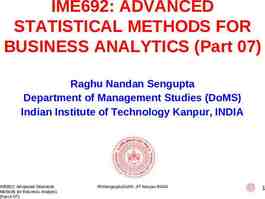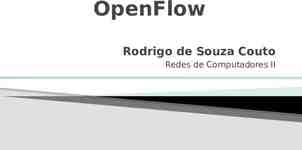An Introduction to Distributed Security Concepts and Public
25 Slides63.00 KB
An Introduction to Distributed Security Concepts and Public Key Infrastructure (PKI) Mary Thompson, Oleg Kolesnikov Berkeley National Laboratory, 1 Cyclotron Rd, Berkeley, CA 94720
Local Computing User sits down in front of the computer Responds to the login prompt with a user id and password. Machine has a list of all the users and their encrypted passwords Password never goes across the network Passwords are encrypted with a one-way code The crypt alogrithm of Unix has been around since mid 70’s. Uses a salt to keep identical passwords from having the same encryption. Uses only 8 characters, case sensitive. Uses 25 iterations of DES. Typically broken by guessing and verifying guess or snooping the password. M.Thompson, O.Kolesnikov, Berkeley National Laboratory
Remote Access Computing User logs in to one or more remote machine(s) Each machine has its own copy of userid and password for each user Changing a password on one machine does not affect the other machines Each time a user connects to a different machine, she must login again In the standard Unix login or rsh commands, the user’s password is sent in clear text over the network or else hosts trust users on the basis of their IP addresses Ssh encrypts the password before sending it or uses a user’s key pair for establishing her identity M.Thompson, O.Kolesnikov, Berkeley National Laboratory
Single Domain Remote Access Computing User gets access to many machines in a single administrative domain. He has a single userid and password for all the machines Can login just once to a central trusted server Examples Kerberos freeware from MIT Project Athena NIS - Sun software with remote access comands M.Thompson, O.Kolesnikov, Berkeley National Laboratory
Kerberos User - password based authentication based on late-70’s Needham -Schroeder algorithms. Kerberos Authentication Server aka KDC (Key Distribution Center) shares long-term secret (password) with each authorized user. User logs in and established a short term session key with the AS which can be used to establish his identity with other entities, e.g. file system, other hosts or services each of which trusts the authority server. The authorization mechanism needs to be integrated with the each function, e.g. file access, login, telnet, ftp, . The central server is a single point of vulnerablity to attack and failure. Been in use for 20 years. We are now at version 5. M.Thompson, O.Kolesnikov, Berkeley National Laboratory
NIS Central server has all the user ids and passwords, don’t need to store passwords locally. Facilitates the same user id and passwords on all machines on a network Then rlogin and rsh allow the user to have access to all the hosts in the hosts.equiv and .rhost files No real security, depends IP addresses Integrated with NFS to allow access to NFS files from any host to which they are exported. M.Thompson, O.Kolesnikov, Berkeley National Laboratory
Cross Domain Authentication Holy Grail is to allow a user to login in once and get access to a ticket that will identify him to all machines on which he is allowed to run. Kerberos supports cross realm authentication, but it is politically difficult to achieve. Used for multiple AFS/DFS cells within a single institution. CMU, DOE weapons labs X.509 Identity certificates. An IETF standard. Contains a multi-part unique name and a public key. The legitimate owner of the certificate has the matching private key. M.Thompson, O.Kolesnikov, Berkeley National Laboratory
Motivation for Universal Identity certificate Distributed computing environments, collaborative research environments Resources, stakeholders and users are all distributed Spanning organizational as well as geographical boundaries, e.g., DOE Collaboratories Requires a flexible but secure way to identify users Requires a flexible and secure way to identify stakeholders M.Thompson, O.Kolesnikov, Berkeley National Laboratory
Security Levels Confidentiality Integrity Assurance of identity of person or originator of data Non-repudiation Maintaining data consistency Authentication Protection from disclosure to unauthorized persons Originator of communications can't deny it later - requires long-term of keys Authorization Identity combined with an access policy grants the rights to perform some action M.Thompson, O.Kolesnikov, Berkeley National Laboratory
Security Building Blocks Encryption provides Checksums/hash algorithms provide confidentiality, can provide authentication and integrity protection integrity protection, can provide authentication Digital signatures provide authentication, integrity protection, and non-repudiation M.Thompson, O.Kolesnikov, Berkeley National Laboratory
Keys Symetric Keys Both parties share the same secret key Problem is securely distributing the key DES - 56 bit key considered unsafe for financial purposes since 1998 3 DES uses three DES keys Public/Private keys One key is the mathematical inverse of the other Private keys are known only to the owner Public key are stored in public servers, usually in a X.509 certificate. RSA (patent expires Sept 2000), Diffie-Hellman, DSA M.Thompson, O.Kolesnikov, Berkeley National Laboratory
Hash Algorithms Reduce variable-length input to fixed-length (128 or 160bit) output Requirements Can't deduce input from output Can't generate a given output Can't find two inputs which produce the same output Used to Produce fixed-length fingerprint of arbitrary-length data Produce data checksums to enable detection of modifications Distill passwords down to fixed-length encryption keys Also called message digests or fingerprints M.Thompson, O.Kolesnikov, Berkeley National Laboratory
Message Authentication Code MAC Hash algorithm key to make hash value dependant on the key Most common form is HMAC (hash MAC) hash( key, hash( key, data )) Key affects both start and end of hashing process Naming: hash key HMAC-hash MD5 HMAC-MD5 SHA-1 HMAC-SHA (recommended) M.Thompson, O.Kolesnikov, Berkeley National Laboratory
Digital Signatures Combines a hash with a digital signature algorithm To sign hash the data encrypt the hash with the sender's private key send data signer’s name and signature To verify hash the data find the sender’s public key decrypt the signature with the sender's public key the result of which should match the hash M.Thompson, O.Kolesnikov, Berkeley National Laboratory
Elements of PKI Certificate Authorities (CA) OpenSSL, Netscape, Verisign, Entrust, RSA Keon Public/Private Key Pairs - Key management x.509 Identity Certificates - Certificate management LDAP servers M.Thompson, O.Kolesnikov, Berkeley National Laboratory
X.509 Identity Certificates Distinguished Name of user DN of Issuer C US, O Lawrence Berkely National Laboratory, OU DSD, CN Mary R. Thompson C US, O Lawrence Berkely National Laboratory, CN LBNL-CA Validity dates: Not before date , Not after date User's public key V3- extensions Signed by CA Defined in ANS1 notation - language independent M.Thompson, O.Kolesnikov, Berkeley National Laboratory
Certificate Authority A trusted third party - must be a secure server Signs and publishes X.509 Identity certificates Revokes certificates and publishes a Certification Revocation List (CRL) Many vendors OpenSSL - open source, very simple Netscape - free for limited number of certificates Entrust - Can be run by enterprise or by Entrust Verisign - Run by Verisign under contract to enterprise RSA Security - Keon servers M.Thompson, O.Kolesnikov, Berkeley National Laboratory
LDAP server Lightweight Directory Access Protocol (IETF standard) Evolved from DAP and X.500 Identities Used by CA's to store user's Identity Certificate Open source implementations Standard protocol for lookup, entry, etc. Access control is implemented by user, password. M.Thompson, O.Kolesnikov, Berkeley National Laboratory
SSL / TLS SSLv3.1 TLS v1.0; NB: WTLS -- TLS for Wireless Links Works over TCP; Application Independent. SSL/TLS allows client/server apps to communicate via a protected channel. Common example -- HTTP over SSL/TLS, e.g. https://www.entrust.com M.Thompson, O.Kolesnikov, Berkeley National Laboratory
SSL Handshake When you type https://www.entrust.com, browser initiates a new SSL/TLS connection. For the new connection SSL Handshake must be performed which will: Negotiate the cipher suite Authenticate the server to the client [optional] Use public-key algorithms to establish a shared session key Authenticate the client to the server [optional] M.Thompson, O.Kolesnikov, Berkeley National Laboratory
SSL Handshake details Client hello: Client’s challenge, client’s nonce Available cipher suites (e.g. DSA/RSA; Triple-DES/IDEA; SHA1/MD5 et al.) Server hello: Server’s certificate, server’s nonce Session ID Selected cipher suite Server adapts to client capabilities Optional certificate exchange to authenticate server/client Usually only server authentication is used M.Thompson, O.Kolesnikov, Berkeley National Laboratory
SSL Handshake completed After the Handshake is completed, SSL session begins Application Data can be transmitted using the established SSL connection / session Example of Application Data: HEAD /index.html HTTP/1.1 HTTP/1.1 200 OK Date: Wed, 11 Jul 2001 08:15:47 GMT [ ] Content-Type: text/html M.Thompson, O.Kolesnikov, Berkeley National Laboratory
Status Single purpose CA’s e.g. Globus (SSLeay) Collaboratory, DOE-Grid (Netscape) Enterprises slow to run CA’s Many different Vendors - Verisign, Entrust, Netscape, RSA Security Keon Incompatible Key and Certificate management between vendors Certificates are not integrated with existing applications that need authorization Large amount of corporate overhead in running a CA Uncertain legal implications of issuing certificates Lab is currently looking at the RSA Keon server as it has integration with ssh and NIS authorization M.Thompson, O.Kolesnikov, Berkeley National Laboratory
Public Key Cryptography Standards - PKCS PKCS 7 PKCS 10 Certification Request Syntax Standard - used by Netscape browser, IE, and SSL libraries PKCS 11 Cryptographic Message Syntax Standard Cryptographic Token Interface Standard - An API for signing and verifying data by a device that holds the key PKCS 12 Personal Information Exchange Syntax Standard - file format for storing certificate and private key - used to move private information between browsers M.Thompson, O.Kolesnikov, Berkeley National Laboratory
References Peter Guttman's tutorial http://www.cs.auckland.ac.nz/ pgut001/tutorial/ about 500 slides covering cryptography, secure connection protocols, PKI, politics and more. RSA Laboratories PKCS specifications http://www.rsasecurity.com/rsalabs/pkcs/ SSL/TLS TLS v 1.0 RFC - http://www.ietf.org/rfc/rfc2246.tx. SSL-v3 http://www.netscape.com/eng/ssl3/draft302.txt OpenSSL http://www.openssl.org/ M.Thompson, O.Kolesnikov, Berkeley National Laboratory






























